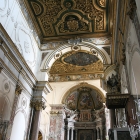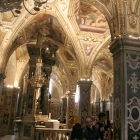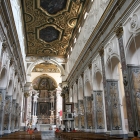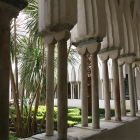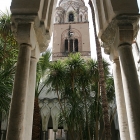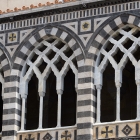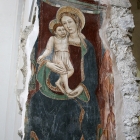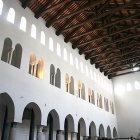St Andrew’s Church in Amalfi, a place where Byzantine art meets Italian Renaissance
According to tradition, St Andrew was the first among the twelve apostles to be called by Jesus to preach His teachings. Andrew was also a fisherman, like his brother, Peter, the founder of the Church. They both spread the Gospel in the Greeko-Roman world and suffered a martyric death, choosing a different shape of the cross they were tortured on as a sign of modesty, so as that the sacrifice of Christ would remain unique. Peter suffered his martyrdom in Rome, where today the Vatican is, while Andrew was killed in Greece, at Patras, on an X shaped cross.
Situated on the magnificent Costiera Amalfitana, on the southern shores of Italian Mediterranean See, Amalfi has St Andrew as its patron. A statue of the apostle can be seen in the central plaza, near a fountain, and depictions are allover the place. But the most famous monument dedicated to the first apostle is of course the fabulous dome, one of the most beautiful churches of the entire world.
The charm of the dome of Amalfi comes from its immemorial tradition that gathered influences from some major civilizations. The first signs of religious constructions on the hill that overlooks the shore date as far as the 6th centuries. Inside the main dome there is a Byzantine church from the 9th century, which you discover while visiting the dome with the feeling of traveling back in time through various architectural styles.
The main dome is also an old construction, it has eight centuries and proves the connections this harbor had with the Byzantine and Arab world. Sitting at the top of a majestic stairway, the dome is richly decorated on the outside in patterns of black an white in a collection of details remembering the Moorish masterpieces in Cordoba, Spain. The arches are rounded and filled with geometrical stone carvings. Ceramic decorations have been used for the round spire of the bells. The heritage of Byzantium is visible in the mosaics and icons with golden background. On the gable there is the icon of Jesus Christ on the throne of Judgment and beneath this splendid glittering mosaic, the twelve apostles are depicted in Roman and Oriental clothes in a style that is identical to those seen in Orthodox churches.
The most magnificent place inside the church complex of Amalfi is a natural place called the Cloister of Paradise. It is an interior garden similar to those found in sultan’s palaces, surrounded by pairs of delicate columns that support intertwining lancet arches. It’s hard to believe that almost eight hundred years ago this was a cemetery for local noblemen.
The main church has a baroque architecture with excessive decorations that were superimposed over centuries old Byzantine frescoes. The 9th century Byzantine church is preserved intact as a distinct area.
The most precious treasure of the dome is of course a part of the relic of St Andrew, stolen from Constantinople during the fourth crusade. This makes Amalfi one of the four cities in the world to have parts of the relics of the first apostle, the others being in Greece, Scotland and Poland.
Besides paintings and mosaics, the church of Amalfi hosts an important art collection. The Angevine Mitre, the papal crown with 20.000 pearls and other gems, a Chalice from the 13th century used for the Eucharistic wine and reliquary chests. The altar of the baroque crypt has a bronze statue of St Andrew by Michelangelo Naccherino, a student of Buonarroti and other statues by Pietro Bernini.
Mai multe despre: Italia, Religious architecture • Amalfi • Apostolul Andrei • Arab art • Byzantine • church • Italia • Italy • St Andrew- Home Page
start page - Architecture
landmark buildings - Sacred architecture
places of worship - Nature
landscape photography - Concert
performing artists - Christmas
Santa Claus pictures
- Jooble
jobs for photographers - Escape
an out of control blog - Merry Christmas
The best organizer of Christmas parties - Astro photo
Eclipse hunting and astrological photography







